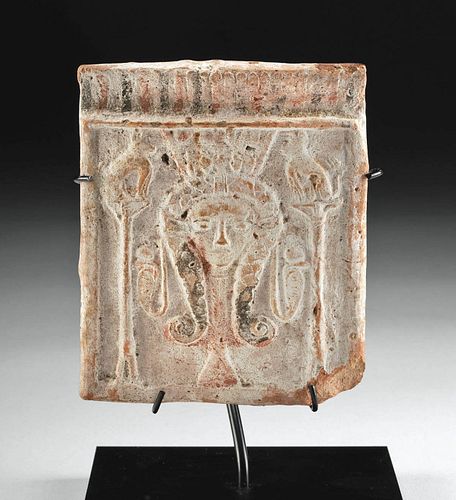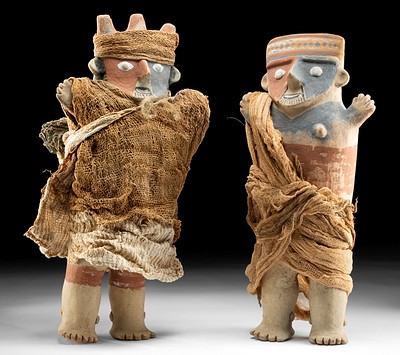Egyptian 26th Dynasty Pottery Pectoral w/ Hathor
Lot 5b
About Seller
Artemis Fine Arts
686 S Taylor Ave, Ste 106
Louisville, CO 80027
United States
Selling antiquities, ancient and ethnographic art online since 1993, Artemis Gallery specializes in Classical Antiquities (Egyptian, Greek, Roman, Near Eastern), Asian, Pre-Columbian, African / Tribal / Oceanographic art. Our extensive inventory includes pottery, stone, metal, wood, glass and textil...Read more
Categories
Estimate:
$4,000 - $6,000
Absentee vs Live bid
Two ways to bid:
- Leave a max absentee bid and the platform will bid on your behalf up to your maximum bid during the live auction.
- Bid live during the auction and your bids will be submitted real-time to the auctioneer.
Bid Increments
| Price | Bid Increment |
|---|---|
| $0 | $25 |
| $300 | $50 |
| $1,000 | $100 |
| $2,000 | $250 |
| $5,000 | $500 |
| $10,000 | $1,000 |
| $20,000 | $2,500 |
| $50,000 | $5,000 |
| $100,000 | $10,000 |
| $200,000 | $20,000 |
About Auction
By Artemis Fine Arts
May 19, 2022
Set Reminder
2022-05-19 10:00:00
2022-05-19 10:00:00
America/New_York
Bidsquare
Bidsquare : Fine Antiquities | Ethnographica | Fine Art
https://www.bidsquare.com/auctions/artemis-gallery/fine-antiquities-ethnographica-fine-art-9350
Featuring a very special collection of Fine Art from the Hollywood Hills, including Picasso & Rookwood ceramics! Also included are many fine examples of classical antiquities, ancient, and ethnographic art from cultures encompassing the globe. Artemis Fine Arts info@artemisgallery.com
Featuring a very special collection of Fine Art from the Hollywood Hills, including Picasso & Rookwood ceramics! Also included are many fine examples of classical antiquities, ancient, and ethnographic art from cultures encompassing the globe. Artemis Fine Arts info@artemisgallery.com
- Lot Description
Egypt, Late Dynastic Period, 26th Dynasty, ca. 664 to 525 BCE. A mold-formed pottery funerary pectoral in the shape of a pylon - the door or gateway into a temple. Covered in white pigment, the cornice-shaped overhang is decorated with vertical black and red stripes and is supported by a pair of border columns. Shown in low relief across the obverse is a pillar with the face of Hathor - goddess of love, music, beauty, and fertility - who bears outstretched ears, ovoid eyes, and intricately plaited bangs with spiraling tips, all beneath a squat crown flanked by a pair of horns. Two uraeus cobras wearing sun discs peer outward on the sides of Hathor's head, and the entire portraiture is bordered by 2 papyrus staffs with umbels surmounted by a cat, perhaps representing the cat goddess Bastet. Size: 3.5" W x 4.2" H (8.9 cm x 10.7 cm); 6" H (15.2 cm) on included custom stand.
Cf. a faience example from the New Kingdom to Third Intermediate Period at The Metropolitan Museum of Art, accession number 26.7.983
Provenance: private New York, New York, USA collection; ex-private Bedfordshire, UK collection, acquired in the 1990s
All items legal to buy/sell under U.S. Statute covering cultural patrimony Code 2600, CHAPTER 14, and are guaranteed to be as described or your money back.
A Certificate of Authenticity will accompany all winning bids.
PLEASE NOTE: Due to recent increases of shipments being seized by Australian & German customs (even for items with pre-UNESCO provenance), we will no longer ship most antiquities and ancient Chinese art to Australia & Germany. For categories of items that are acceptable to ship to Australia or Germany, please contact us directly or work with your local customs brokerage firm.
Display stands not described as included/custom in the item description are for photography purposes only and will not be included with the item upon shipping.
#172086Small loss to lower corner as shown. Abrasions, chips, softening to finer details, and fading to pigment commensurate with age, with light pitting in scattered areas. Small area of oxidation near upper corner suggests this was deposited next to an object containing iron. Great preservation to most detailing and pigments. Old inventory label on base of display stand.Condition
- Shipping Info
-
All shipping is handled in-house for your convenience. Your invoice from Artemis Gallery will include shipping calculation instructions. If in doubt, please inquire BEFORE bidding for estimated shipping costs for individual items.
-
- Buyer's Premium



 EUR
EUR CAD
CAD AUD
AUD GBP
GBP MXN
MXN HKD
HKD CNY
CNY MYR
MYR SEK
SEK SGD
SGD CHF
CHF THB
THB













